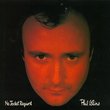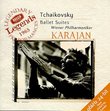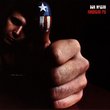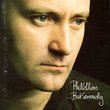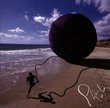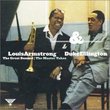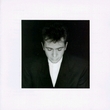| All Artists: Maurice Ravel, Charles Münch, Boston Symphony Orchestra Title: Ravel: Bol�ro, Rapsodie espagnole, La Valse, Pavane pour une infante d�funte, Ma m�re l'oye Members Wishing: 0 Total Copies: 0 Label: RCA Victor Gold Seal Release Date: 7/5/1991 Album Type: Original recording remastered Genre: Classical Styles: Historical Periods, Modern, 20th, & 21st Century Number of Discs: 1 SwapaCD Credits: 1 UPC: 078635652222 |
Search - Maurice Ravel, Charles Münch, Boston Symphony Orchestra :: Ravel: Bol�ro, Rapsodie espagnole, La Valse, Pavane pour une infante d�funte, Ma m�re l'oye
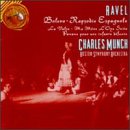 | Maurice Ravel, Charles Münch, Boston Symphony Orchestra Ravel: Bol�ro, Rapsodie espagnole, La Valse, Pavane pour une infante d�funte, Ma m�re l'oye Genre: Classical
|
Larger Image |
CD DetailsSimilarly Requested CDs
|
CD ReviewsA truly terrifying La Valse Keith Peters | 07/17/2000 (4 out of 5 stars) "This was one of my first classical discs which I bought in 1963. It trumpeted the RCA Dynagroove process, had Bolero on the first side and Pavane and La Valse on the other side. This CD now includes Rapsodie Espagnole and Mother Goose, both recorded in the late 1950s. All of the pieces would be fine first choices for a basic library. The Bolero is powerful with Munch adding extra drums for the finale, though Munch speeds up the tempo during the piece. The Pavane is a rather quick runthrough, but James Stagliano's horn solo is quite beautiful. The CD's biggest selling point is the La Valse. As Munch conducts it, this has to be one of the most terrifying pieces ever composed, up there with Bartok's Miraculous Mandarin and Stravinsky's Le Sacre de Printemps. The BSO is right there with him all the way. Both the Rapsodie and the Mother Goose are quite beautiful. As usual, Richard Mohr and Lewis Layton did a marvelous job of recording these pieces." Wow--What a La Valse Hermes Camacho | Boulder, CO | 02/05/2002 (5 out of 5 stars) "If you were to ask me the one reason the buy this CD, it would be for Munch's La Valse. It is absolutely spectacular. I remember the first time I heard this piece when I was younger, but never had it this much power. The compilation itself is a must. Munch was considered to have been the foremost Ravel interpreter of his time (today, it's Charles Dutoit). The Bolero is quite brilliant, and Munch touches-up the score at the end enough for the effect he wanted, but discretely enough as not to distort Ravel's score. It's one of the most exciting Boleros I've heard.The Pavane is not a piece I'm particularly fond of by itself, but I believe Munch conducts it superbly and the horn solo is quite full of longing.The Rapsodie Espagnole is another winner in this compilation. The finale of the last movement is exquisite, Munch bringing out a very Stravinsky-esque quality from it (Stravinsky and Ravel both studied with Rimsky-Korsakov, the first master orchestrator).The Mother Goose Suite is a piece I first encountered in my high school orchestra. I really didn't appreciate the work until this performance with Munch and the BSO. One can really see pictures in the mind's eye through his interpretation. The third movement is my personal favorite. He gives it just the right taste. Another recording to check out is the one Michael Tilson-Thomas made with the Philharmonia (I believe). The La Valse is amazing and breathtaking througout. The opening has just the right ammount of tension to foreshadow the climactic ending, but just enough to give way to the playful melody that follows. One can really hear Strauss' sound in the waltz, with a Ravel twist. The finale is fantastic and may terrify the weak of heart. The BSO is right on the heel of Munch and he's got them by the reins, giving just the right ammount of tension. Munch's control and restraint that gave this piece that tension would have made Toscanini proud!A must recording, it's not just one to get, but THE one to get." Powerful and Sensuous Jeffrey Lee | Asheville area, NC USA | 05/21/2004 (5 out of 5 stars) "I thought it would be interesting to compare performances of some of the major works of Ravel by listening to recordings of three long acknowledged masters of mainstream French repertoire---Pierre Monteux, Charles Munch and Jean Martinon. All three offer nearly identically recorded selections, though Martinon's is a two disc set which includes some additional fine works by the composer. Otherwise, Munch plays the original Suite From Mother Goose, while Monteux and Martinon provide us with Ravel's later, sequence altered and more complete ballet version. Each conducts a different orchestra. Monteux has the London Symphony, Munch the Boston Symphony and Martinon the Orchestra de Paris. To keep the playing field level, my comments will concern only those recorded pieces that are common here to the three cds.
Bolero, of course, is Ravel's most popular composition, and also one of the favorites of the entire classical repertoire. Many have enjoyed its exotic strains, though some attest it has been overexposed and have "gotten tired of it". Nevertheless, each presents a fine performance, but I believe Martinon's is the most impressive in both sonics and interpretation. Those characterful French woodwinds certainly do sing. Moreover, the sound is cleaner than that given to the others, and the perspective on the orchestra is close to ideal. Monteux's version, however, is solid. It is straightforward and musical. Munch's strength comes in the last portions of the piece....In the Rhapsodie Espagnole Martinon scores again, with a reading that captures best the sense of color, sensuous atmosphere and flair the work is full of. Munch's Symphony Hall sound in Boston displays warmth and richness, and he too offers a fine reading. Monteux seems only slightly less interesting than the others....In La Valse all three present enjoyable accounts. Monteux brings a nice rhythmic lilt and a hint of playful, romantic charm. Munch emphasizes drive and elan, though he borders on being boisterous at times. Martinon sings with lyricism and luxurious sensuality....Pavane For a Dead Princess has Munch taking top honors. He imparts an air of nobility and an almost timeless quality. There is also some very beautiful harp playing....Finally, in Ma Mere l'Oye (Mother Goose) all three give very fine performances. Munch is superbly dynamic, colorful and tuneful. Monteux is poignant and loving. Martinon lays things out very clearly and nicely, and there is an easy yet animated flow to his presentation as well as a fine atmosphere of child-like spirit and fantasy. Yes, overall, I tend to favor Martinon, but there's a lot to appreciate in Munch and Monteux. I really don't think you will go wrong with any of these choices." |

 Track Listings (12) - Disc #1
Track Listings (12) - Disc #1